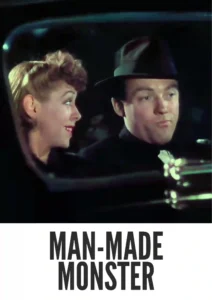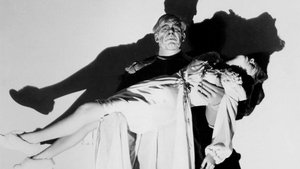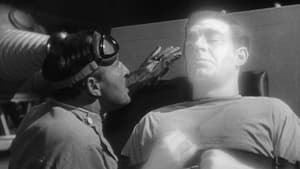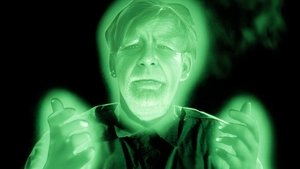Contact: info@alwanfilm.com
Video Sources 0 Views
- Watch trailer
- Man-Made Monster 1941 Colorized


Man-Made Monster 1941 Colorized
Synopsis
Table of Contents
ToggleMan-Made Monster 1941 Colorized Review: A Classic Sci-Fi Horror in Early Color

Introduction
In the world of classic science fiction and horror films, Man-Made Monster (1941) stands out as a fascinating early experiment in blending scientific anxieties with supernatural horror. Directed by George Waggner, this film introduced audiences to the chilling possibility of technology gone awry, with a monster that is more machine than man. While originally released in black and white, the subsequent colorized version offers a fresh take on the film’s eerie atmosphere. In this article, we will explore the enduring legacy of Man-Made Monster, the significance of its colorized version, and how it impacted the horror and science fiction genres during the 1940s.
Check The Full Colorized Movies List
Check Our Colorized Movies Trailer Channel
Understanding Man-Made Monster 1941 Colorized: Director, Cast, and Genre
Director’s Vision
George Waggner, a seasoned director known for his work on Universal’s horror films, brought a unique vision to Man-Made Monster (1941). Waggner had a particular talent for creating tension and atmosphere, both of which are critical elements in this film. His direction ensures that the film maintains a consistent pace, building up suspense before unleashing its monster on the unsuspecting world. Waggner’s keen understanding of both the horror and science fiction genres allowed him to craft a story that combines elements of both, creating a film that is unsettling yet compelling.
The Iconic Performance of Actors
The film stars Lon Chaney Jr. as the tragic lead, Dan McCormick, who is transformed into the “man-made monster” by a mad scientist’s experiments. Chaney, who would later become a staple in Universal’s monster universe with roles like the Wolf Man, delivers a powerful performance in this early role. He brings both physical presence and emotional depth to McCormick, making him more than just a mindless creature. McCormick is a tragic figure, manipulated and tortured by forces beyond his control, and Chaney portrays his descent into monstrosity with heartbreaking subtlety.
Lionel Atwill, another regular in Universal horror films, plays Dr. Paul Rigas, the film’s villainous scientist. Atwill’s portrayal of Rigas is chilling; he is cold, calculating, and utterly convinced of the righteousness of his experiments. The dynamic between Atwill’s Rigas and Chaney’s McCormick forms the emotional core of the film, creating a classic struggle between man, monster, and the hubris of science.
Exploring the Genre
Man-Made Monster (1941) is a fusion of the horror and science fiction genres, a combination that was relatively new at the time. The film explores the consequences of reckless scientific experimentation, a theme that would become increasingly popular in post-World War II science fiction. Its focus on electricity as a tool for both creation and destruction taps into contemporary fears about technological advancements, particularly as the world was on the cusp of major scientific breakthroughs during the 1940s.
The horror elements, especially the transformation of an ordinary man into a monstrous creature, adhere to the conventions of the Universal monster films that were incredibly popular in the 1930s and 1940s. The blend of science fiction and horror in Man-Made Monster makes it a unique entry in both genres, setting the stage for future films that would explore the darker side of scientific progress.
Exploring the World of Man-Made Monster 1941 Colorized: Plot and Characters
Detailed Synopsis
Man-Made Monster (1941) tells the story of Dan McCormick, a man who survives a horrific bus accident that exposes him to a massive dose of electricity. Seemingly unharmed by the experience, McCormick becomes the subject of Dr. Paul Rigas’ twisted experiments. Rigas, a scientist obsessed with the potential of electrical energy, believes that he can turn McCormick into a powerful, electrically charged being. He subjects McCormick to increasingly dangerous levels of electricity, transforming him into a living conduit of electrical power.
As McCormick becomes more and more reliant on electrical energy to survive, he loses his humanity, becoming a monstrous tool for Rigas’ ambitions. The film builds to a dramatic climax as McCormick, now fully transformed into the “man-made monster,” is forced to confront his creator and the tragic consequences of his unnatural transformation.
The Complex Protagonist and Memorable Supporting Characters
Dan McCormick, as portrayed by Lon Chaney Jr., is a tragic figure—a man turned into a monster against his will. His journey from an ordinary person to an electrically charged monster is both heartbreaking and terrifying. Chaney’s performance brings a sense of pathos to the character, making the audience sympathize with McCormick’s plight even as he becomes increasingly dangerous.
Dr. Paul Rigas, played by Lionel Atwill, is the archetypal mad scientist, a character whose scientific genius is outweighed by his moral corruption. His willingness to manipulate and destroy McCormick for the sake of his experiments is chilling, making him one of the more memorable villains in Universal’s horror canon.
The supporting cast, including Anne Nagel as June Lawrence, adds emotional depth to the story. Nagel’s performance as the caring yet frightened love interest provides a counterbalance to the cold scientific world of Dr. Rigas, emphasizing the human cost of his experiments.
The Art of Film Colorization
Understanding the Process
Colorization, the process of adding color to black-and-white films, involves painstaking attention to detail, frame by frame. When Man-Made Monster (1941) was colorized, modern technology allowed filmmakers to enhance the film’s visual appeal without sacrificing the mood and tone of the original. The goal of colorization is to make classic films more accessible to contemporary audiences while preserving the integrity of the original cinematic experience.
Colorization can be seen as an art form in itself, as the colors must be carefully chosen to match the time period, the emotions of the scenes, and the director’s original vision. The addition of color to Man-Made Monster breathes new life into its visuals, highlighting the contrast between McCormick’s human form and his monstrous, electrically charged transformation.
Development Over Time
The technology behind colorization has evolved significantly since the early days of hand-painting individual frames. Modern digital tools allow for more accurate and seamless colorization, making films like Man-Made Monster (1941) appear more natural in color than ever before. While some purists argue that black-and-white films should remain untouched, others appreciate the way colorization can introduce classic films to new audiences.
Early Colored Films: A Brief History
Emergence of Early Colored Techniques
Color films were a rarity in the early 20th century, with black-and-white films being the standard. However, filmmakers experimented with various color techniques, such as tinting, toning, and the early two-color Technicolor process. These methods gave audiences their first glimpses of color on screen, though they were often limited in scope and quality.
It wasn’t until the 1930s that full-color films became more widely available, thanks to the development of three-strip Technicolor, which allowed for a broader and more vibrant color palette. Films like The Wizard of Oz (1939) and Gone with the Wind (1939) showcased the potential of color in cinema, paving the way for the colorization of older films like Man-Made Monster.
Man-Made Monster and Its Early Colored Version
The Decision to Release in Color
The decision to colorize Man-Made Monster was likely driven by a desire to modernize the film for contemporary audiences. By adding color to the film, the filmmakers hoped to enhance its visual appeal and make it more accessible to viewers who might be unfamiliar with black-and-white cinema. The colorized version of Man-Made Monster offers a fresh perspective on the film’s eerie atmosphere, bringing out the details of the laboratory sets, the electrical effects, and the transformation of McCormick into a monster.
Impact on the Visual Narrative
Colorization changes the way audiences experience Man-Made Monster. In black and white, the film’s stark contrasts and shadows contribute to its eerie mood, evoking the classic horror atmosphere of early Universal monster films. In color, these same elements take on new dimensions. The electricity that courses through McCormick’s body becomes more visually striking, and the lab equipment glows with an otherworldly intensity. However, some argue that the colorization diminishes the film’s original mood, as the black-and-white version’s simplicity and darkness better convey its themes of scientific hubris and human tragedy.
The Debate Over Film Colorization
Controversy Surrounding Colorization
Colorizing black-and-white films has long been a subject of debate among filmmakers, critics, and cinephiles. Opponents of colorization argue that it alters the director’s original vision and can compromise the film’s artistic integrity. They point out that many black-and-white films were specifically designed to use light and shadow to create mood, and adding color can disrupt the careful composition of these elements.
On the other hand, proponents of colorization see it as a way to bring classic films to new audiences. They argue that many viewers today are less likely to watch black-and-white films, and colorization makes these films more appealing and accessible. In the case of Man-Made Monster, colorization offers a new way to experience the film, allowing modern audiences to appreciate its visual elements in a fresh light.
Examining Man-Made Monster as an Early Colored Film
Enhancement or Distraction?
The colorization of Man-Made Monster provides an interesting case study in how color can enhance or detract from the viewing experience. For some, the added color highlights the film’s visual elements, making McCormick’s transformation more dramatic and the electrical effects more striking. The colorized version also emphasizes the contrast between the sterile, scientific world of Dr. Rigas’ laboratory and the organic, human world outside.
However, others feel that the black-and-white version better serves the film’s tone. The original version’s use of shadows and stark lighting creates a more oppressive and claustrophobic atmosphere, which suits the film’s themes of confinement and dehumanization. Ultimately, whether the colorization enhances or detracts from the viewing experience is a matter of personal preference.
Influence and Legacy: Man-Made Monster 1941 Colorized’s Impact on Cinema
Contribution to the Sci-Fi Horror Genre
Man-Made Monster (1941) played a significant role in shaping the sci-fi horror genre, particularly in its exploration of the dangers of unchecked scientific experimentation. Its themes of technology gone awry and the dehumanization of individuals through scientific means would become recurring motifs in later science fiction films, particularly during the Cold War era, when fears of nuclear technology and government experimentation were at their height.
The film’s blending of horror and science fiction also influenced later monster movies, particularly those produced by Universal Studios. Lon Chaney Jr.’s portrayal of McCormick as a tragic, sympathetic figure would set the standard for future monster characters, many of whom would share the same sense of tragic inevitability.
Director’s Cinematic Legacy: Beyond Man-Made Monster 1941 Colorized
George Waggner’s Influence on Filmmaking
George Waggner’s work on Man-Made Monster solidified his reputation as a skilled director within the horror genre, and his later work on The Wolf Man (1941) cemented his place in Universal’s monster movie legacy. Waggner’s ability to combine horror with emotional depth and his use of scientific themes in his films would influence a generation of filmmakers, both in the horror genre and beyond. His work continues to be studied and appreciated by film historians and genre enthusiasts alike.
Themes Explored in Man-Made Monster
Dark Themes of Science, Power, and Humanity
At its core, Man-Made Monster is a cautionary tale about the dangers of scientific hubris and the consequences of playing God. The film explores the moral implications of using science to manipulate life, raising questions about power, control, and the ethical boundaries of scientific research. Dr. Rigas’ obsession with his experiments and his willingness to sacrifice McCormick’s humanity for the sake of scientific progress speaks to the darker side of human ambition.
The film also addresses themes of isolation and dehumanization, as McCormick becomes increasingly disconnected from his own identity and humanity. His transformation into a monster is not just physical but emotional, as he loses touch with the world around him and becomes a tool for Rigas’ ambitions.
Reception and Controversy Surrounding Man-Made Monster 1941 Colorized
Initial Reviews and Audience Reactions
Man-Made Monster (1941) received generally positive reviews upon its release, with critics praising Lon Chaney Jr.’s performance and the film’s atmospheric tension. The film’s exploration of scientific experimentation and its moral implications resonated with audiences, particularly as the world entered an era of rapid technological advancement during World War II.
However, the colorized version of the film has sparked some controversy among film purists. While some appreciate the visual enhancement that colorization brings, others feel that the black-and-white version better captures the film’s tone and themes. The debate over whether to preserve the original aesthetic or embrace modern technology continues to be a point of contention among fans and critics.
Where to Watch Man-Made Monster 1941 Colorized Online
For those interested in experiencing Man-Made Monster (1941), both the original black-and-white version and the colorized release are available on popular streaming platforms. Services like Amazon Prime Video, iTunes, and YouTube offer rental and purchase options, and DVD and Blu-ray editions of the film are also available for collectors.
FAQs About Man-Made Monster 1941 Colorized
Q: What is the significance of Man-Made Monster in the context of Universal’s horror films?
A: Man-Made Monster is an important entry in Universal’s horror canon, blending science fiction and horror in a way that was relatively new at the time. It introduced themes of scientific hubris and dehumanization, which would become common in later monster films.
Q: How does the colorized version of Man-Made Monster change the viewing experience?
A: The colorized version adds visual appeal, particularly in highlighting the electrical effects and the transformation of McCormick. However, some feel that the black-and-white version better suits the film’s tone and themes.
Q: Who stars in Man-Made Monster (1941)?
A: The film stars Lon Chaney Jr. as Dan McCormick, the man turned into a monster, and Lionel Atwill as Dr. Paul Rigas, the mad scientist responsible for his transformation.
Q: What are the major themes of Man-Made Monster?
A: The film explores themes of scientific hubris, power, dehumanization, and the ethical boundaries of scientific research. It also addresses the consequences of using technology to manipulate life.
Conclusion
Man-Made Monster (1941) is a fascinating blend of science fiction and horror, offering a cautionary tale about the dangers of unchecked scientific ambition. Lon Chaney Jr.’s performance as the tragic McCormick, combined with George Waggner’s atmospheric direction, creates a film that is both chilling and thought-provoking. The colorized version offers a new way to experience this classic, though the original black-and-white version remains a testament to the power of early cinematic horror. Whether viewed in color or its original format, Man-Made Monster continues to captivate audiences and stands as a significant entry in the legacy of Universal’s monster films.

















